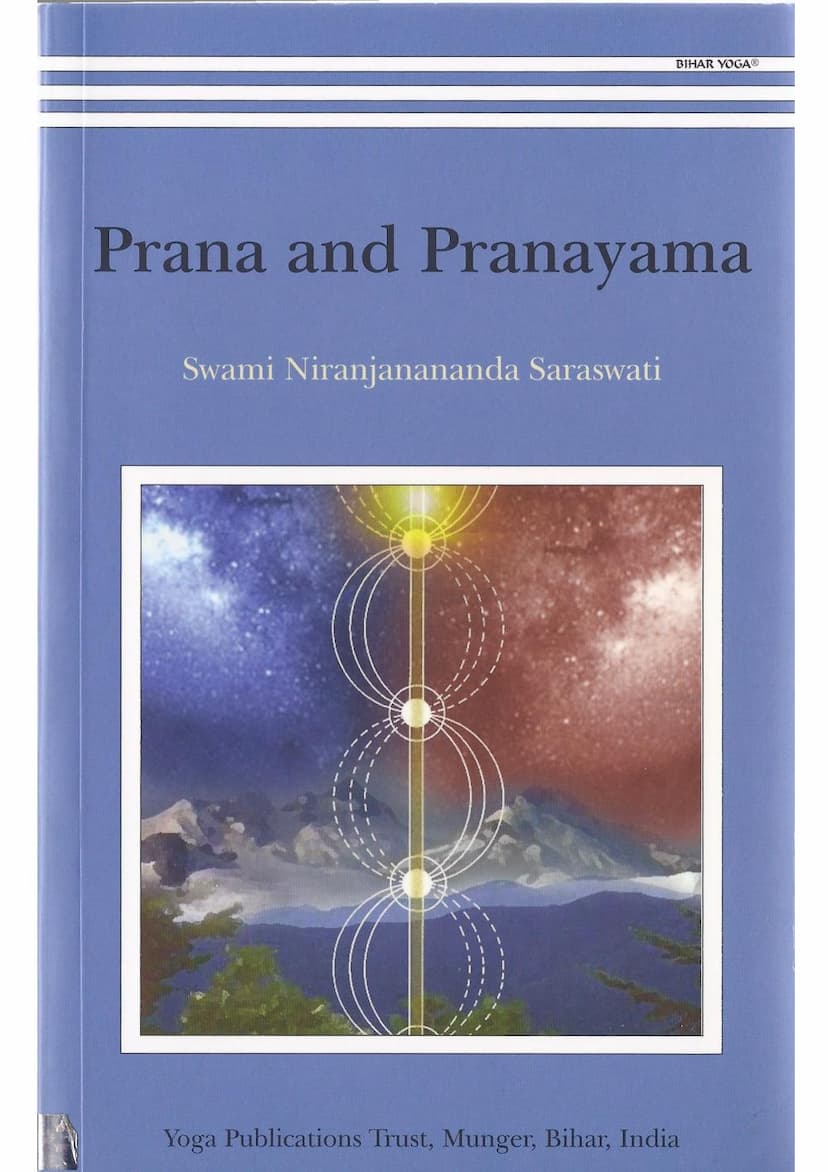Pran And Pranayam
Added to library: September 2, 2025

Summary
The book "Prana and Pranayama" by Swami Niranjanananda Saraswati, published by Yoga Publications Trust, is a comprehensive guide to the yogic science of prana (life force) and pranayama (its control and expansion). It aims to bridge the gap between ancient yogic wisdom and modern understanding, making the classical practices accessible and applicable to contemporary practitioners.
Key Concepts and Structure of the Book:
The book is divided into three main parts, supported by appendices and a glossary, offering a holistic approach to pranayama.
Part 1: Theoretical Foundation
- Prana: The book begins by defining prana not just as breath but as the fundamental vital force that sustains all existence, both animate and inanimate. It explores the concept of cosmic prana (mahaprana) as the creative impulse arising from consciousness, and individual prana as its manifestation within a being. Prana is described as a multi-dimensional energy, intricately linked with consciousness (chitta) and desire (vasana).
- Pancha Koshas: The book elaborates on the five sheaths or dimensions of human existence, from the physical (annamaya kosha) to the blissful (anandamaya kosha). It explains how prana pervades and connects these sheaths, and how pranayama practices help in traversing them.
- Chakras: The seven primary energy centers along the spine are detailed, describing their locations, associated elements, bija mantras, and their role in storing, transforming, and distributing prana.
- Nadis: The text explains the concept of nadis as subtle energy channels through which prana flows. It highlights the importance of ida, pingala, and sushumna – the three main nadis – and their connection to the nervous system, brain hemispheres, and the flow of consciousness.
- Pancha Prana: The five primary vital forces (prana, apana, samana, udana, vyana) that operate within the body are explained, along with their physiological and subtle effects, and indications of their imbalance. It also briefly touches upon the five minor pranas.
- Five Keys to Pranic Awareness: The book outlines five essential elements for developing pranic awareness: psychic breath, psychic passage, psychic centres, psychic sound, and psychic symbol.
- Prana and Mantra: The intrinsic relationship between sound and prana is explored, emphasizing how mantras, as cosmic sounds, are powerful tools for transmitting prana shakti and influencing consciousness. The significance of initiation and the proper use of mantras are highlighted.
Part 2: Physiological Basis and Research
- Physiology of Respiration: This section delves into the anatomy and physiology of the respiratory system, explaining the structure of the lungs, respiratory muscles, and the process of inhalation and exhalation.
- Respiratory Control: It discusses the nervous and chemical mechanisms that regulate breathing and how yogic practices can influence these systems, leading to control over the autonomic nervous system and altered states of consciousness.
- Yogic Physiology of the Nose: The crucial role of the nasal passages in pranayama is explained, including their connection to mooladhara chakra and the brain, and the science of Swara Yoga which relates breath flow to mental states.
- Research on Breath and Pranayama: The book presents scientific research findings on the effects of various pranayama techniques on the body and mind, including their impact on the cardiovascular system, stress reduction, immune system, and athletic performance. It highlights studies on Nadi Shodhana, Ujjayi, Bhramari, Kapalbhati, Bhastrika, and Kumbhaka, showcasing both historical yogic understanding and modern scientific validation.
Part 3: Practical Application of Pranayama
- Conscious Breathing: This section provides foundational practices for developing awareness of the breath, including techniques like counting the breath and exploring the mechanics of breathing.
- Basic Breathing Methods: It introduces diaphragmatic, thoracic, and clavicular breathing, explaining their physiological functions and how to integrate them into yogic breathing (full yogic breathing).
- Preliminary Breathing Practices: This includes techniques for developing breath control and capacity, such as deep breathing, viloma pranayama (interrupted breathing), rhythmic breathing, extended exhalation, and basic kumbhaka practices.
- Tranquillizing Pranayamas: Detailed instructions are given for cooling practices like Sheetali, Sheetkari, Kaki, Ujjayi, and Moorchha pranayamas, emphasizing their calming and introverting effects.
- Vitalizing Pranayamas: This section covers heating and stimulating practices like Swana, Bhastrika, and Kapalbhati pranayamas, explaining their energizing effects and therapeutic applications.
- Surya Bheda Pranayama: This practice focuses on stimulating the solar energy (pingala nadi) and is explained with various stages and precautions.
- Plavini Pranayama: An unusual practice involving swallowing air for internal cleansing and sustenance.
- Guidelines for Pranayama: This chapter provides crucial advice on the prerequisites for pranayama, including preliminary practices, diet, place, time, posture, cleanliness, and the importance of regularity, patience, and faith. It also outlines precautions and possible side effects.
- Nadi Shodhana Pranayama: A detailed explanation of the purification of energy channels, presented in progressive stages from beginner to advanced, including the introduction of kumbhaka and bandhas.
- Classical Pranayamas: The book details various classical pranayama techniques, including Tranquillizing Pranayamas (Sheetali, Sheetkari, Kaki, Ujjayi, Moorchha, Chandra Bheda) and Vitalizing Pranayamas (Swana, Bhastrika, Kapalbhati, Surya Bheda).
Appendices: The book includes several appendices that complement the main text:
- Supplementary Practices: Jala Neti and Sutra Neti for nasal cleansing, and Agnisara Kriya for digestive fire activation.
- Asanas Relevant to Pranayama: Descriptions and illustrations of various sitting and other postures that support pranayama practice.
- Mudras Relevant to Pranayama: Explanations of hand gestures and their energetic implications.
- Bandhas Relevant to Pranayama: Details on the three primary locks (jalandhara, uddiyana, moola) and maha bandha, and their role in controlling and redirecting prana.
- Hatha Yoga Pradipika Pranayama Sutras: Selected verses from this foundational text that offer authoritative insights into pranayama.
Overall Message: "Prana and Pranayama" emphasizes that pranayama is a profound science leading to transformation at physical, mental, psychic, and spiritual levels. It encourages a systematic, patient, and aware approach to the practice, highlighting the indispensable role of a qualified guru for advanced stages and spiritual evolution. The book aims to empower readers with the knowledge and techniques to harness their own vital energy for overall well-being and self-realization.